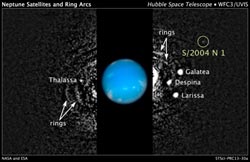NASA Hubble Finds New Neptune Moon

This composite Hubble Space Telescope picture shows the location of a newly discovered moon, designated S/2004 N 1, orbiting Neptune. The black and white image was taken in 2009 with Hubble’s Wide Field Camera 3 in visible light. Hubble took the color inset of Neptune on August 2009. <br>Image Credit: NASA, ESA, M. Showalter/SETI Institute<br>
The moon, designated S/2004 N 1, is estimated to be no more than 12 miles across, making it the smallest known moon in the Neptunian system. It is so small and dim that it is roughly 100 million times fainter than the faintest star that can be seen with the naked eye. It even escaped detection by NASA's Voyager 2 spacecraft, which flew past Neptune in 1989 and surveyed the planet's system of moons and rings.
Mark Showalter of the SETI Institute in Mountain View, Calif., found the moon July 1, while studying the faint arcs, or segments of rings, around Neptune. “The moons and arcs orbit very quickly, so we had to devise a way to follow their motion in order to bring out the details of the system,” he said. “It's the same reason a sports photographer tracks a running athlete — the athlete stays in focus, but the background blurs.”
The method involved tracking the movement of a white dot that appears over and over again in more than 150 archival Neptune photographs taken by Hubble from 2004 to 2009.
On a whim, Showalter looked far beyond the ring segments and noticed the white dot about 65,400 miles from Neptune, located between the orbits of the Neptunian moons Larissa and Proteus. The dot is S/2004 N 1. Showalter plotted a circular orbit for the moon, which completes one revolution around Neptune every 23 hours.
The Hubble Space Telescope is a cooperative project between NASA and the European Space Agency. NASA's Goddard Space Flight Center in Greenbelt, Md., manages the telescope. The Space Telescope Science Institute (STScI) in Baltimore, Md., conducts Hubble science operations. STScI is operated by the Association of Universities for Research in Astronomy Inc., in Washington.
For images, video, and more information Neptune's new moon, visit: http://hubblesite.org/news/2013/30
For more information about the Hubble Space Telescope, visit: http://www.nasa.gov/hubble
Media Contact
All latest news from the category: Physics and Astronomy
This area deals with the fundamental laws and building blocks of nature and how they interact, the properties and the behavior of matter, and research into space and time and their structures.
innovations-report provides in-depth reports and articles on subjects such as astrophysics, laser technologies, nuclear, quantum, particle and solid-state physics, nanotechnologies, planetary research and findings (Mars, Venus) and developments related to the Hubble Telescope.
Newest articles

Superradiant atoms could push the boundaries of how precisely time can be measured
Superradiant atoms can help us measure time more precisely than ever. In a new study, researchers from the University of Copenhagen present a new method for measuring the time interval,…

Ion thermoelectric conversion devices for near room temperature
The electrode sheet of the thermoelectric device consists of ionic hydrogel, which is sandwiched between the electrodes to form, and the Prussian blue on the electrode undergoes a redox reaction…

Zap Energy achieves 37-million-degree temperatures in a compact device
New publication reports record electron temperatures for a small-scale, sheared-flow-stabilized Z-pinch fusion device. In the nine decades since humans first produced fusion reactions, only a few fusion technologies have demonstrated…





















